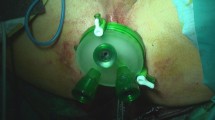Abstract
Background
Complete pathological resection of locally advanced and recurrent anorectal cancer is considered the most important determinant of survival outcome. Involvement of the retropubic space with cancer threatening or involving the penile base poses specific challenges due to the potential for margin involvement and blood loss from the dorsal venous plexus. In the present study we evaluate a new transperineal surgical approach to excision of anterior compartment organs involved or threatened by cancer which facilitates exposure and visualisation of the bulbar urethra and the deep vein of the penis caudal to the retropubic space and penile base.
Methods
A retrospective study was performed on male patients with tumour extension into the penile base treated at our institution using the transperineal surgical approach. Descriptive data for patient demographics, radiology, operative details, postoperative histology, complications and outcomes were collated.
Results
Ten male patients with tumour extension into the penile base were identified. Two patients had recurrent anal cancer, 6 had locally advanced primary rectal cancer and 2 had recurrent rectal cancer. All patients had exenterative surgery with excision of the penile base utilising the transperineal approach. All patients had R0 resection. No local recurrence developed after a median follow up period of 15 months.
Conclusions
The transperineal approach to the penile base and retropubic space allows for high rates of R0 resection margin status with direct visualisation of the dorsal venous plexus, thereby minimising blood loss. In our experience, this technique is the preferred approach to excision of cancers threatening and involving the penile base and also for most male patients requiring total pelvic exenteration.







Similar content being viewed by others
References
De Wilt JH, Vermaas M, Ferenschild FT, Verhoef C (2007) Management of locally advanced primary and recurrent rectal cancer. Clin Colon Rectal Surg 20:255–263
Sk W, Ag H, Lynch AC (2016) Surgery for locally recurrent rectal cancer: tips, tricks, and pitfalls. Clin Colon Rectal Surg 29:114–122
Bhangu A, Ali SM, Brown G, Nicholls Rj TP (2014) Indications and outcome of pelvic exenteration for locally advanced primary and recurrent rectal cancer. Ann Surg 259:315–322
Bhangu A, Ali SM, Darzi A, Brown G, Tekkis P (2012) Meta-analysis of survival based on resection margin status following surgery for recurrent rectal cancer. Colorectal Dis 14:1457–1466
Heriot AG, Byrne CM, Lee P, Dobbs B, Tilney H, Solomon MJ et al (2008) Extended radical resection: the choice for locally recurrent rectal cancer. Dis Colon Rectum 51:284–291
Hansen MH, Balteskard L, Dorum LM, Eriksen MT, Vonen B, Norwegian Colorectal Cancer Group (2009) Locally recurrent rectal cancer in Norway. Br J Surg 96:1176–1182
Nielsen MB, Rasmussen PC, Lindegaard JC, Laurberg S (2012) A 10-year experience of total pelvic exenteration for primary advanced and locally recurrent rectal cancer based on a prospective database. Colorectal Dis 14:1076–1083
Harji DP, Griffiths B, Mcarthur DR, Sagar PM (2012) Current UK management of locally recurrent rectal cancer. Colorectal Dis 14:1479–1482
Helewa RM, Park J (2016) Surgery for locally advanced T4 rectal cancer: strategies and techniques. Clin Colon Rectal Surg 29:106–113
Brunschwig A (1948) Complete excision of pelvic viscera for advanced carcinoma; a one-stage abdominoperineal operation with end colostomy and bilateral ureteral implantation into the colon above the colostomy. Cancer 1:177–183
Shaikh I, Holloway I, Aston W, Littler S, Burling D, Antoniou A et al (2016) High subcortical sacrectomy: a novel approach to facilitate complete resection of locally advanced and recurrent rectal cancer with high (S1–S2) sacral extension. Colorectal Dis 18:386–392
Milne T, Solomon MJ, Lee P, Young JM, Stalley P, Harrison JD (2013) Assessing the impact of a sacral resection on morbidity and survival after extended radical surgery for locally recurrent rectal cancer. Ann Surg 258:1007–1013
Melton GB, Paty PB, Boland PJ, Healey JH, Savatta SG, Casa-Ganem JE et al (2006) Sacral resection for recurrent rectal cancer: analysis of morbidity and treatment results. Dis Colon Rectum 49:1099–1107
Shaikh I, Aston W, Hellawell G, Ross D, Littler S, Burling D, et al (2014) Extended lateral pelvic sidewall excision (Elsie): an approach to optimize complete resection rates in locally advanced or recurrent anorectal cancer involving the pelvic sidewall. Tech Coloproctol 18:1161–1168
Shaikh IA, Jenkins JT (2017) Extended pelvic side wall excision for locally advanced rectal cancers. World J Gastroenterol 23:8261–8262
Solomon MJ, Brown KG, Koh CE, Lee P, Austin KK, Masya L (2015) Lateral pelvic compartment excision during pelvic exenteration. Br J Surg 102:1710–1717
Austin KK, Solomon MJ (2009) Pelvic exenteration with en bloc iliac vessel resection for lateral pelvic wall involvement. Dis Colon Rectum 52:1223–1233
Solomon MJ, Austin KK, Masya L, Lee P (2015) Pubic bone excision and perineal urethrectomy for radical anterior compartment excision during pelvic exenteration. Dis Colon Rectum 58:1114–1119
Beyond Tme Collaborative (2013) Consensus statement on the multidisciplinary management of patients with recurrent and primary rectal cancer beyond total mesorectal excision planes. Br J Surg 100:1009–1014
Chan S, Miller M, Ng R, Ross D, Roblin P, Carapeti E et al (2010) Use of myocutaneous flaps for perineal closure following abdominoperineal excision of the rectum for adenocarcinoma. Colorectal Dis 12:555–560
Devulapalli C, Jia W, At D, Ml B, Pa B, Sm S et al (2016) Primary versus flap closure of perineal defects following oncologic resection: a systematic review and meta-analysis. Plast Reconstr Surg 137:1602–1613
Hainsworth A, Al Akash M, Roblin P, Mohanna P, Ross D, George ML (2012) Perineal reconstruction after abdominoperineal excision using inferior gluteal artery perforator flaps. Br J Surg 99:584–588
Peirce C, Martin S (2016) Management of the perineal defect after abdominoperineal excision. Clin Colon Rectal Surg 29:160–167
Acknowledgements
The authors would like to thank Steve Preston for his invaluable assistance in developing the schematic diagrams used in this manuscript.
Author information
Authors and Affiliations
Corresponding author
Ethics declarations
Conflict of interest
The authors declare that they have no conflict of interest.
Ethical approval
As the current study was retrospective analysis of established clinical practice, formal consent was not required.
Informed consent
All patients provided informed consent prior to surgery.
Rights and permissions
About this article
Cite this article
Mehta, A.M., Hellawell, G., Burling, D. et al. Transperineal retropubic approach in total pelvic exenteration for advanced and recurrent colorectal and anal cancer involving the penile base: technique and outcomes. Tech Coloproctol 22, 663–671 (2018). https://doi.org/10.1007/s10151-018-1852-8
Received:
Accepted:
Published:
Issue Date:
DOI: https://doi.org/10.1007/s10151-018-1852-8




